A
| Agnews office railing |
|---|

A surviving example of highly decorative Victorian or Edwardian decorated cast iron work More Information |
| Ardlui gate |

Possibly made by Emil Rzechorzek, a steel gate and house sign combined that although of a later period perfectly attunes with the 'art deco' style of which the town has such fine surviving examples. More Information |
| Art-deco Shops |

Possibly Colonel Tawse and Messrs Hall, 1936. Single storey and 2-storey with attic, 6-bay, terraced, Art Deco style former Co-operative building adjoining separately listed Carron Restaurant, Cameron Street. Fine decoratively-astragalled top-lights, coloured glass medallions and original shop doors with brass door furniture. Granite ashlar shop fronts, with crenellated, crowstepped darker ashlar 1st floor bays; harl and coursed rubble to side. Oversized stylised keystone and capitals. |
B
| Barrie Fountain, Stonehaven |
|---|

Polished granite. Small free standing Gothic drinking fountain. Baptismal font style circular bowl on octagonal pier with scroll supports at splayed faces; corniced, open square columned canopy above, each face with round-arch and decoratively-tooled spandrels supported by central column and 4 corner colonettes with stiff-leaf capitals; this surmounted by ornamental pyramidal spirelet rising from decoratively-tooled gablets, inscribed E gablet reading '1897 Presented to the Town of Stonehaven by George Barrie, Law Agent and Notary Public, Edinburgh', tooled band course and square-plan stiff-leaf capital capped by metal colonette (probably for gas lamp, lamp now missing). Associated horse trough, probably later, adjacent (see below). |
| Beachgate House Sign |

Painted Wooden Bed and Breakfast sign incorporating the Scottish Tourist Board ranking sign, sign is topped with a silhouette of a trawler called Helene. More Information |
| Burns garden, second Burns bust and Laura Anne memorial stone |

A small civic garden near the Cowie River crossing on the north side of the town centre. |
C
| Carron River Falls |
|---|

Predominately a civil engineering project but its aesthetic pretensions may just make it eligible for inclusion. A system of weirs create a man made series of waterfalls with boulder built embankments. More Information |
| Carron Terrace Houses |

Single storey and attic, 5-bay terraced pair of boldly detailed, late classical houses; No 8 with late 19th to early 20th century single storey, single bay wing. Ashlar. Base and eaves courses. Consoled cornices to doors and to 3 advanced tripartite windows, latter with coupled outer consoles and block pediments rising above eaves. |
| Christians house Doorway Arch |

An ornate decorative cast iron arch supporting a large lantern of orange-red glass, which presumably was once illuminated by an oil or gas lamp. |
| Church of the Immaculate Conception , various architectural decoration, windows and, soup kitchen |

The Church of the Immaculate Conception is the last remaining place of worship in Stonehaven's Old Town. It boasts details recognised as deriving from Notre-Dame-le-Grand, Poitiers and Chartres and despite the loss of some original glazing is nevertheless an important quiet place on its island site surrounded by roads and behind the High Street. The building date varies from 1875 to 1879 depending upon the source, but it is a certainty that funds for this fine church and the nearby Rickarton Cottages were provided by Mrs Eliza Maria Hepburn of Rickarton, as a memorial to her daughter. A sketch in Christie's 'Haven Under The Hill', entitled 'Church of St Mary' shows decorative ridge detail and a ship weathervane, neither of which are evident today (2004). He also mentions an American organ which was installed in April 1880. The priest´s house is located at the nearby (separately listed) Rickarton Cottages and is accessible from the church grounds. The nearby soup kitchen was presented to the church by George Blackie in 1905. |
| Cowie Mill, decorations |

Original Mill; was 18th-19thC; remodelled 1920 a 2-storey and attic 11 bay main block, with a 3-storey block and a large pyramidal-roofed kiln at rear. The kiln vent is hexagonal, with revolving cap. The central low breast wheel has been removed and the lade destroyed; was recently derelict, though workings part remained. Then was converted in the late 1990's into flats. Various old wheels and gears have been used to 'decorate' the grounds as well as the pig on the kiln vent. More Information |
D
| Dolphin sculpture, Stonehaven |
|---|

A Dolphin created from a network of steel rods in the characteristic style of many of this artist's public projects in Scotland, Australia etc. More Information |
| Dunnottar Cemetery Stonehaven, general info |
|
There have been a number of churches on the present site. The original church, dedicated to St. Bridget in 1394, was replaced in 1593 by the 5th Earl Marischal (George Keith), which in turn was replaced in 1782 by a much larger church. The church was completely reconstructed in 1903 and remodelled into a cruciform plan by G.P.K. Young of Perth, with parts of the 1782 church incorporated into the present building. The kirk is of a rectangular plan built of granite rubble with Gothic details. There is a plain ball-capped bellcote on the E. gable. |
| Dunnottar Cemetery Stonehaven, Sextant on Old Stone |

An elegant relief carved recumbent stone with motifs of a sextant and dividers clasped in hands surrounded by an ornate baroque cartouche of scroll work with memento mori at the corners. Presumably the grave of a navigator. More Information |
| Dunnottar Cemetery Stonehaven, various memento mori |

Tombstones dating from the 17th & 18th century may be engraved with emblems of mortality, such as skulls, bones, the sexton’s spade and turfcutter, or an hourglass symbolising the sands of time running out the words "memento mori" themselves are sometimes also inscribed . These older stones may be embellished with winged souls, often at the top of the headstone, to represent the hope of resurrection and immortality. More Information |
| Dunnottar Cemetery Stonehaven, 17th Century Headstone |

A tombstone dated 1685 with primitive engraved memento mori including a skull very like a bowling ball. More Information |
| Dunnottar Cemetery Stonehaven, Celtic Cross |

Early 20th century Celtic revival free standing stone Celtic Cross with fine carved relief decoration featuring strap work interlace More Information |
| Dunnottar Cemetery Stonehaven, Headstone of Town Bellman |

Upright stone of a typical Victorian 'Gothic revival' pointed arch shape for James Kemlo, town’s officer and bellman for sixteen years, died 1889 the stone also commemorates an Elizabeth Edward who died in 1868 aged 88. (the lichen makes athe inscrition hard to read but I think it says she was James Kemlo's mother). The stone is relief carved with a hand bell resting on a shelf flanked by stylised thistles. More Information |
| Dunnottar Cemetery Stonehaven, Headstone with Tools |

An early upright stone relief carved with what looks like a slater's tools. More Information |
| Dunnottar Cemetery Stonehaven, Merchants Headstone |

Upright gravestone with the traditional merchants symbol like a figure 4. More Information |
| Dunnottar Cemetery Stonehaven, Skull on Churchyard Wall |

An extremely realistic and well executed carved skull set in the kirkyard wall above an upright stone that itself bears an upward looking relief of a skull, much eroded, on its top surface. More Information |
| Dunnottar School, schoolhouse decoration |

A rather dour late Victorian piece of public architecture in sandstone with some nice decorative details. More Information |
E
| Ellerslie - door, ironwork & stained glass |
|---|

House dated 1892, altered and extended. 2-storey, 5-bay, rectangular-plan, end terrace house (sub-divided) with keystoned and pedimented moulded door-piece, tall round-arched stair window with decorative astragals and coloured glass (the round medallions containing portrait heads) and some fine interior detail; on ground falling to S and E. Painted ashlar with ashlar margins, quoin strips and base course to W; ashlar with 1st floor cill course and eaves cornice to E. |
F
| Far & Wide sign |
|---|

A painted globe with a superimposed cross and lettering, presumably the logo of a missionary organisation. More Information |
| Features at Dunnottar Castle |

The castle; probably occupies the site of a prehistoric fort. St Ninian established a church here about the beginning of the 5thC. It may also be the -Dunfoithir- besieged in 681. In the reign of William the Lion (1165-1214) -Dunnottar- was the place where warrants were returnable for the Mearns, and -le castiel de Dunostre- is mentioned at the beginning of the 13thC. Another castle was erected at the end of the 14thC. In its final form the castle was forfeited in 1716 and the roofs and floors removed and sold. In 1925 the systematic repair and excavation of the ruins was begun.In its present form the extensive remains date from various periods. The oldest portion is the early 15thC keep with a range of buildings extending to the E containing stables & storehouses. The gatehouse is approached by a steep path and defended by three tiers of splayed gun-loops. The arched entrance is the only opening on a solid wall of masonry set into a cleft in the rock; a very impressive and dominating entrance. The buildings to the NW grouped round a courtyard date from the late 16th or early 17thC, including a chapel. A huge water system lies within the courtyard. There is also a bowling green to the W of this later range. The Scottish Crown jewels (The Honours of Scotland) were hidden here in 1651 as it was considered one of the strongest places in the kingdom. In 1685 167 Covenanters were packed into a small vault, (the Whigs Vault) where 9 died due to the terrible conditions. Privately owned (Dunecht Estates) and open to the public. An oval motte was noted in 1970. More Information |
| Fettercairn Mercat Cross |

Fettercairn will have had some kind of market cross since 1504 when the status of a free burgh of barony was first granted. It is is said by some that the shaft of the current cross originally stood in the burgh of Kincardine which declined and eventually ceased when the judicial headquarters of the county moved to Stonehaven in 1600. There is no historical record of the cross being moved in this manner. |
| Fettercairn the Royal Arch |

A triumphal arch of Rhenish Romanesque style; round arch between two high buttressed octagonal towers with short gabletted spirelets and wrought-iron finials. The top of the arch is finished with a crenellated parapet with a curvilinear gablet feature at the centre. It was the winner of a competition, assessed by Queen Victoria, to commemorate a visit by Victoria and Albert in 1861. More Information |
| Fetteresso Castle Doocot |

A well preserved 16th-century beehive dovecot stands on the edge of a field, Dovecot; tall beehive shaped dovecot of 16thC; three rat ledges; flight hole in top; stands beside a pond to the SE of the castle. More Information |
| Fetteresso Castle Gates |
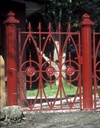
Modern painted ironwork gates, with a relief cast flower motif. |
| Fetteresso New Cemetery, Stonehaven: Gravestones,and wrought iron gates |

Large municipal cemetery on the outskirts of Stonehaven opened in 1902 to serve the increasing population of the area. There are about 1600 gravestones within Fetteresso New, the majority of which are constructed from local granite, the three illustrated are however later 20th century (80s and 90s) stones of imported black granite. They are of interest in showing a modern take on visual iconography, two of them illustrating occupations as do the gravestones of earlier times from some older graveyards. The grounds were extended to the north-west in the late 20th century with a new entry gate constructed for easy access. More Information |
| Fetterresso Parish Church Door Stonehaven |
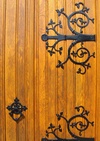
2-leaf, vertically-boarded timber door (replaced 1995), large decorative ironwork hinges, and deep timber-traceried, pointed-arch fanlight with diamond-pattern, leaded glazing and modern wall-mounted carriage lamps flanking. More Information |
| Flower-pot men |

An installation of figures made from wood and flower-pots beside a ready made? sundial. More Information |
G
| Graffiti, Stonehaven |
|---|

A fairly typical example of monochrome tag, text and cartoon based graffiti by an unambitious spry painter. More Information |
| Greenden House Sign |

Simple welded steel sign with free standing lettering and scrollwork More Information |
H
| Harbour/Tolbooth Sundial |
|---|

Dated 1710. Free standing sundial. Cubic sandstone head with chamfered angles; horizontal dial with wrought-iron gnomon. Short, square-section shaft, also with chamfered angles, off-set below More Information |
| Helicopter Wind Vane |

Painted metal weather vane in the form of a black and white helicopter. More Information |
| Hotel Sign - Royal Hotel, Allardice Street |

Decorative metalwork parapet with 'ROYAL HOTEL' lettering, More Information |
| House Sign - Smithy Cottages |

A painted plastic house sign of the 'guess who lives here sort', a more modern take on the local cut steel tradition, with a nicely foreshortened grand piano More Information |
| House sign - Threelums |

Carved oak panel showing the three lums (Scots for chimneys) with the lettered word threelums like smoke above them More Information |
J
| Jubilee Fountain, Torphins |
|---|

An ornate stone fountain in a somewhat confused idiom, on a stepped base, the cover supported on 4 polished pink granite columns is surmounted by a squat column terminating in a carved crown. More Information |
M
| Mackie Academy War Memorial - Arduthie School |
|---|

Sandstone, bronze |
| Marine Hotel carved heads |

(possibly 17th century, certainly older than the 1884 date of the building) carved heads thought to have originated at the nearby Dunnottar Castle, situated to the south of Stonehaven. Although badly weathered, the fine carving can still be seen on those of the human and lion heads. |
| Marine Hotel Shield Datestone |

A shield shaped datestone decorated with an anchor and 2 monograms More Information |
| Mosaic entrance - Unique shop |

A well preserved example of a late 19th or early 20th century black and white mosaic shop entrance More Information |
| Mosaic entrance - Unique shop |

A well preserved example of a late 19th or early 20th century black and white mosaic shop entrance More Information |
| Mosaic Obelisk |

An amorphous cement obelisk decorated with polychrome ceramic /glass tesserae. More Information |
| Mosaic Telecom access covers, Stonehaven |

Mosaic tiles on a steel cover plate, arranged in a grid of 24 squares showing nautical and marine iconic imagery. More Information |
N
| National Cycle route marker, Stonehaven |
|---|

Cast metal Way-Marker erected to indicate a point on the national cycle route network. Contains images relating to local geology. The important fossil bearing strata of the local. Part of a millennium cycle route project funded by the Millennium commission. The shape of the whole piece is obviously intended to suggest the tail of a fish or a whale, I am not sure which. More Information |
| New Street, Railings & serpent and eagle wall ornaments |

There are two sets of interesting railings opposite each other. The right hand one is composed of equal armed crosses, pommée, (bottom photograph) there is additional iron work relief set inside the garden wall to the left with a matched pair of eagles, painted black, in conflict with serpents painted red. They are in a cement wall which has railings on top. The figures are cast iron, they sit on an iron rail and the back of the recess is also lined with iron or steel. The recess in which they sit is mirrored on the opposite wall of the joint garden with No.10. That recess has rust marks which show that another pair of similar figures resided in that recess |
P
| Pithie memorial sundial |
|---|

A sandstone sundial on a square section pillar with chamfered corners mounted on cuboid pedestal. There are words carved around the edge that indicate it is a memorial to '??thie born 8th June 1836'. Below there are words but they are not readable On the back there is 'A Pithie' then 'born', the next bit has gone but the year seems to be 1812. The base is inscribed "W. Pithie mason 1857" More Information |
| Plague Stones - Gravestones |

Near to plague burial-ground; plague or victims were interred not here but in a nearby hollow to the south east of Victoria Street, at a site known as The Maltman's How. The site is now occupied by modern buildings and gardens. Two gravestones were found about 1842 (which had lain on a what at that time was a piece of waste ground, they were then erected against a bank on the left of the path opposite the Bog Well ) and are now set into the E wall of a public footpath at NO 8741 8552. Stone to N dated 1608 with death's head and shield incorporating 'MT' monogram, reading 'Heir lyes ane honest man, Magnvs Tailiovr, seyman, qvha depairtit in November, (in the time of) pest 1608'. Stone to S dated 1648 and reading 'Heir lyes ane Honest mans bairns Alexander and William Brokie, sones lawful to Alexander Brokie, who departet the 12 of Jwnie, of the age of tvalf and nyn yeirs old, in ano 1648'. More Information |
R
| Railway bridge heraldic Shields / Crests |
|---|

Carved sandstone shields with a lion holding a falchion type sword, The inscription is virtute et opera "by virtue and deeds" More Information |
| Ramsays shop door, house entrance, mosaic and other details |

Full-width scroll-consoled fascia over ground floor shop with deep-set doors, with mosaic-tiled step, comprising bevelled glazing with beaded oval and curved astragals below deep plate glass fanlight, and flanking curved lights to bays. More Information |
| Rickarton Cottages -cast iron railings - cast-iron parapet + memorial stone |

Single storey and attic, 8-bay, short terrace of cottages with rusticated porches and pavilion centre with timber verandah. decorative cast iron railings No 5 low saddle-back-coped ashlar boundary walls with battered ashlar gatepiers to No 3, and decorative cast-iron railings to No 5, cast iron parapet at No 3 and the memorial stone, it is inscribed "erected as a memorial of William Rickart Hepburn Esq of Rickarton who died 30th May 1873" |
S
| Sailboat Mobile |
|---|

A colourful rotating exterior kinetic installation created from model sailing boats. More Information |
| Shell House |

A small domed oven shaped building of old bricks, lined with mosaics of shells. Set in a hard landscaping of cobbles with a small pool etc. More Information |
| Ships Cannon reused as a bollard |

An old cast metal ship's cannon set vertically as a bollard into the pavement on the way from the town centre to Stonehaven harbour. More Information |
| Shorehead Information board |

A sloping mosaic panel that surely draws on the local wealth of 'art deco' design, artefacts and buildings. With an inset information panel. It is set on a contrasting plinth of rough masonary. More Information |
| Sign - Ian Edwards |

An enamelled metal sign with a large red arrow and blue lettering and a representation of a 1930s convertible on a white background. I do not know whether this fairly recent sign is a commercial production or home-made but it resonates with the areas legacy of art Deco. More Information |
| Slate cairn, Bervie Braes information point |

A hemispherical slate cairn with a, metal bound, circular slate-mosaic upper surface with an inset information panel. More Information |
| St James the Great, Episcopal Church Stonehaven, carving of the head of Christ |

A contemporary bas-relief in wood of the head of a crucified Christ made in Jakarta Indonesia for Ian and Barbara McNab, who presented it to the church. More Information |
| St James the Great, Episcopal Church Stonehaven, Duff Memorial |

Relief carved stone panel in an architectural style with crenellated top and side columns, with armorial decoration, memorial to the Rt. Hon. Sir Robert William Duff of Fetteresso, Governor of New South Wales 1893-95. Presented by the 'women of New South Wales' as a tribute of sympathy to Lady Duff. More Information |
| St James the Great, Episcopal Church Stonehaven, general |
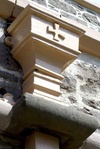
Architects Sir Robert Rowand Anderson, nave 1875-7; Anderson with Arthur Clyne, chancel, organ chamber and vestry 1883-5, builder John Morgan; Arthur Clyne, narthex and baptistery 1906, latter with Sir Ninian Comper glass of 1929. Transitional church with 5-bay nave, low buttressed side aisles and clerestorey, crowstepped lean-to narthex and semi-octagonal baptistery with prismatic roof. NE organ chamber, SE sacristy and choir vestry of semi-octagonal plan, adjoining slim tower with circular belfry stage; apsidal choir. Squared and snecked rubble with some Aberdeen bond, and ashlar dressings. Deep base course, continuous hoodmoulds forming string courses, eaves course and blocking courses to baptistery and vestry. Principally round-arched openings, quatrefoil and trefoil-headed to vestry, pointed-arch to NW aisle openings, and vessica to NW gablehead of nave. Squat, 2-stage coped buttresses; voussoirs; hoodmoulds with label stops; raked cills; chamfered reveals. 2-leaf vertically-boarded timber doors with decorative ironwork hinges. INTERIOR: fine arcaded Romanesque interior with round columns and uncut capitals, clerestory windows and hammeberbeam roof to nave; tall chancel arch and ribbed timber-lined barrel-vaulted roof to chancel and apse. Fixed timber pews. Narthex with 2-leaf screen door in pointed-arch opening with decoratively-astragalled leaded panels and fanlight. Apse with high altar and elaborately sculptured reredos. More Information |
| St James the Great, Episcopal Church Stonehaven, organ |

An example of a highly decorated neo-Gothic Victorian church pipe organ with gold-leaf and painted ornamentation. More Information |
| St James the Great, Episcopal Church Stonehaven, pulpit |

Decoratively carved Caen stone pulpit designed by Arthur Clyne, built under the supervision of sculptor James Bremner of Broughty Ferry, incorporating quatrefoil panels with carved heads of (according to the Listed Building Record): St. James, King David of Scotland 1124-1153, Bishop Forbes, Bishop Keith and Bishop Jolly bishop of Moray 1798-1838. This above information is contradicted by the information given in the church and Booklet on the history of St. James Church, available in the church, this lists the heads on the pulpit as: St Ninian (of Candidacasa aka Whitehouse) 397-432, St David King of Scotland 1124-1153, John Sinclair bishop of Brechin 1565-66, Alexander Jolly bishop of Moray 1798-1838, and Alexander Penrose Forbes bishop of Brechin 1847-75 (my own view based on the clothing/facial hair, much more like a Victorian interpretation of Middle Eastern clothing than Brythonic Celtic, is that the LBR is right about the first head being intended as St. James). Carved with the quote "heaven and earth shall pass away but my words will not pass away". The green marble balls at the angle of the panels above and below come from Egypt and the red from Victoria in South Africa. More Information |
| St James the Great, Episcopal Church Stonehaven, Reredos |

Elaborately sculptured reredos by Gambier Perry of London, memorial to Mrs Annette Maria Baird of Ury, nee Palk (1884), incorporating 4 crocketted and finialled, pointed-arch, trefoil-headed niches supported by columns of Devonshire stone, with five alabaster figures, of Sts Andrew, Peter, James and John (brother of James), flanking larger niche with seated Christ carved in high relief above an alabaster tabernacle, with brass bound wooden doors. More Information |
| St James the Great, Episcopal Church Stonehaven, stained glass |

STAINED GLASS: some fine coloured glass, including apsidal window depicting 'Christ crucified' by Clayton & Bell of London, flanked by windows depicting on left, the carrying of the cross and the flagellation, and on right the descent from the cross; West window is a memorial to Dean Christie showing 'Christ's Baptism' and 'Baptism from the Tolbooth window' (this illustrates the Rev. Alexander Greig baptising infants from the Tolbooth window while imprisoned in 1748 by the Hanoverian authorities for holding a service attended by more than 5 persons); memorial windows to nave including 'The Good Samaritan' commemorating Leslie Thomson and family of Invercowie House, 'St James' memorial to the Adams Family (1832-1955), and 'Angel' in memory of Alexander Innes of Raemoor, died 1882. Sir Ninian Comper's baptistery windows commemorate David MacDonald, headmaster of Episcopal school. |
| St Kierans well Stonehaven AKA St Ciaráns Well, Mineral Well Park fountain (Chalybeate) |
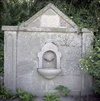
An elegant pedimented fountain of Peterhead granite, the basin is backed by an ornate niche decorated with a carved scallop shell in high relief. The plaque reads "St Kierans well erected by public subscription A.D. 1860" More Information |
| St. Bridgets Church , Stonehaven |

G P K Young, Perth, 1886. Arts and Crafts style church converted as church hall, with 6-bay buttressed nave, large shallow-pitched roof with canopied bell-housing, jerkinhead dormers and decoratively-finialled square-plan spirelet; piended session room and porch. Squared and snecked rubble with smooth ashlar dressings. Base course and cill course at gablehead window. Voussoired, round-headed door. 2-stage coped buttresses. Chamfered reveals, raked cills and timber mullions to cusped 3-light windows in rectangular openings. Modern flat-roofed hall. |
| St. Ciaráns Kirk Stonehaven, armorial plaques |

Two badly eroded and lichen covered armorial monuments, they are now hard to read or distinguish the devices but enough remains to indicate a high quality of decorative carving. More Information |
| St. Ciaráns Kirk Stonehaven, bellcote detail |

A nice little bellcote in dressed stone with ornate gableing, but lacking a bell More Information |
| St. Ciaráns Kirk Stonehaven, blacksmiths stone |

A beautifully cut stone almost like an engraved book plate of the period. The crown and hammer blacksmiths' symbol can be seen at the top of this headstone. It is inscribed " 1823 RSIMK To the memory of RICHARD SMITH once blacksmith of URE and late farmer of ALLARDICE who died the 6th Sept 1822 aged 67 years" More Information |
| St. Ciaráns Kirk Stonehaven, Duff Memorial |

A superb white marble tombstone to the memory of Rbt. Wllm. Duff of Fetteresso, dated 1834, features a finely carved armorial panel in a good pediment. Also inscribed to his wife Mary Abercromby Duff who died 1833, it was erected by their son Robert and the inscription also commemorates his early death at the age of 31 in 1861. More Information |
| St. Ciaráns Kirk Stonehaven, gardeners stone |

A memorial to 'John Smart late gardener at Barras who died 13th Feb 1798 aged 43 yrs' (the tools at the top of the stone of which the spade is familiar as a memeto mori thus here function as a trade emblem) an inscription is appended to his wife 'Christian Masson who died in 1847' two other commemorations follow to an Alexander Smart 1913 and to his wife Elizabeth Glegg Burnett 1926. Like other stones in this database with inscriptions produced from the end of the 18th to the beginning of the 20th centuries it shows an interesting modification some would say a deterioration in the standard lettering style. More Information |
| St. Ciaráns Kirk Stonehaven, general |

Scheduled Ancient Monument. |
| St. Ciaráns Kirk Stonehaven, granite obelisk |
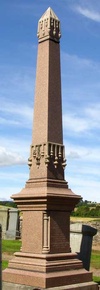
Pink granite obelisk in a classical style. The inscription reads: "In affectionate remembrance of William Mowat Leather Merchant |
| St. Ciaráns Kirk Stonehaven, stones showing Mortality Emblems |

Various headstones with memento mori symbols. The oldest, in the top photograph, appears to be dated 1600 pre-dating most of the surviving ruins. More Information |
| St. Ciaráns Kirk Stonehaven, various Victorian stones |

Stones of 1860s-70s in various styles derived from Victorian neo-gothic and neo-classical. More Information |
| St. Ciaráns Kirk Stonehaven, watchmakers stone |

An elegant Victorian stone dedicated to a watchmaker, Robert Edwards, decorated with foliage, a flower motif and scrolls. More Information |
| Stonehaven Art Deco Open Air Swimming Pool |

Rectangular-plan, 320,000 gallon, open air heated seawater swimming pool (55 yards x 20 yards) with long, single storey, pantiled, Art Deco, entrance range comprising turnstiles, café and flanking changing rooms; stepped buttressed enclosure walls. Painted poured concrete. More Information |
| Stonehaven Beach Waveform |

A dry garden of shingle, cut timbers and boulders, in a style derived at some distance from Japanese Zen dry gardens that seems to have become popular for public installations. More Information |
| Stonehaven Boardwalk furniture |

Public seating area with decking and modernist bench constructed from massive sawn timber More Information |
| Stonehaven Boardwalk Bird with Fish sculpture |

A new welded metal sculpture depicting a Common Shag, Phalacrocorax aristotelis (identifiable by its distinctive breeding crest that distinguishes it from the Great Cormorant Phalacrocorax carbo). It is holding a fish in its beak. More Information |
| Stonehaven Boardwalk Salmon |

A welded metal sculpture of a cock salmon, if it was inspired by Andy Scott's nearby work I think the anonymous creator outdid that work with this piece that while being thoroughly contemporary has the resonance of the ancient Pictish Salmon symbol. It is to be hoped that its disappearance does not mean it has been destroyed by the sea or vandalism. More Information |
| Stonehaven Court House Roof Railings |

19th century gothic revival decorative ironwork based on a trefoil motive, installed along the roof ridge. The more recent seagull defences of chicken wire somewhat spoil the overall effect. More Information |
| Stonehaven Mercat Cross |

It is a simple stone-shafted cross, square at base but splayed above, resting on an octagonal base. The head of the cross was replaced by the present one which bears the Marischal Arms in 1887 when it was remodelled for Queen Victoria's golden jubilee visit. |
| Stonehaven Railway Station Canopy |

Station; opened c1850 by the Aberdeen Railway; a 2 platform through station, with the main offices on the up platform, in a 2-storey ashlar building, with the platform at first floor level. There is an unusually heavy cast iron-framed platform awning. Still in use. Cast by Saracen Foundry Glasgow manufactured by Walter Macfarlane & Co. The supporting brackets are decorated with ornate scrollwork. More Information |
| Stonehaven Tolbooth Gates |

Heavy wrought iron gates in a grid pattern with protruding scrolls at top and bottom of the vertical bars. The building dates from the 1500s but I do not know if the gates are contemporary with it. More Information |
| Stonehaven War Memorial |

Sandstone and Granite The Stonehaven war memorial stands on a hill to the southeast of the town overlooking the bay. It commemorates the dead of both World War I & II. It is built to represent a ruined Greek temple, and is octagonal in shape with Doric columns supporting an entablature. It sits on a raised dais with eleven steps leading up to a small wrought iron gate. Stone benches run around the interior between the pillars. The names of battles are carved into the lintels over the pillars. The architect was John Ellis of Aberdeen and the memorial was dedicated on the 23rd of May 1923 at 3pm. More Information |
| Stonehaven, Ship Inn Sign |

A cut (or perhaps forged) steel or iron sign in the form of a three masted schooner. The holes at the head of the fore and mizzen masts suggest the sign was originaly designed to hang. More Information |
| Sunshine Plaque Torphins |

Polychromed stone relief showing a griffin holding a star and quarter section of a solar disc. Built into a fascinatingly |
T
| Tewel - Farm Signs |
|---|

The unique welded lettering on the gate is in keeping with the area's vibrant art deco heritage, the mass produced cast metal sign with charolais bull is however something that at the moment could be anywhere in Britain. More Information |
| The Carron Restaurant |

Colonel Tawse and Messrs Hall, 1936; renovated 1999-2000 by Hall and Tawse. Tall single storey and basement, 3-bay, piend-roofed, Art Deco restaurant with bowed concrete-pillared loggia/verandah and bowed front comprising Art Deco glazing to large windows combining vertical and horizontal patterning with Deco symbols, set on terrace above period garden. Banded brick and reinforced concrete. |
| The First Burns Bust |

Sandstone bust of the poet Robert Burns (b. 25 Jan 1759 d. 21st July 1796, at the age of 37) on a columnar pedestal by Robert Taylor 'Ghosty Bob' a local monumental mason and sculptor (his nickname a result of his work carving many gravestones). This was the first statue of Burns that the artist did. Both works ultimately derive from the 1787 portrait by Alexander Nasmyth (1758-1840). This seems to be regarded as the definitive image and has been used as a source for most of the huge number of later representations, it is certainly more flattering than the portrait painted by Peter Taylor in 1786. |
| The Milestone and Commemorative Keystone |

Sandstone commemorative stone worded 'THEOBALD BARCLAY 1150' 'MATHERS 1351 URIE' (see Notes below) from the 1781 bridge re-cut and set into wall below a milestone which is incised with BERVIE 10 / L(signifing Laurencekirk)14 / A(signifing Aberdeen)14. More Information |
| The Mill Inn |

Late 18th century and circa 1830, converted to flats in 1998. 2-storey and attic, 7-bay, L-plan former coaching inn converted to flatted dwellings late 20th century, with hexastyle colonnade. Red sandstone ashlar with coursed squared rubble to sides, squared and snecked rubble and some harl to rear. Cornice and blocking course. |
| The White Bridge Stonehaven |

A highly decorative late-Victorian footbridge. Single span, shallow segmental-arched, cast-iron footbridge over Carron Water. Cast in 3 sections with dated makers plaque to centre of riveted girder, wrought-iron quatrefoil parapet, cast-iron standards with wrought-iron arch at centre, and pyramidally-coped, stop-chamfered ashlar terminal piers. |
| Thistle Garden Gates |

Painted welded steel decorative garden gates incorporating large Scottish thistle emblems. More Information |
| Torphins War Memorial |

The memorial is a simple erect large slab of granite around the base of which is built a low wall of rough hewn granite. The plaques bearing the names are built into the wall on either side of the block and at the base of it. The memorial seems to quote the styles of the areas neolithic past, having resonances of both a megalithic standing stone and a burial cairn. It was erected 11 June 1922 More Information |
U
| Untitled Sculpture |
|---|

A concrete or ciment fondue sculpture of 2 figures joined in a gymnastic or acrobatic position. More Information |
W
| Weavers Cottage Stained glass House Door |
|---|
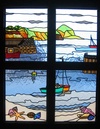
A contemporary front door with four inset stained glass panels forming a harbour landscape in naive style More Information |
| Woodburn - house sign |

Painted metal Bed and Breakfast sign using a lettering style reminiscent of mid-20th century trade signs. More Information |
This content was submitted by external contributors and does not necessarily reflect the views of the University of Aberdeen.
